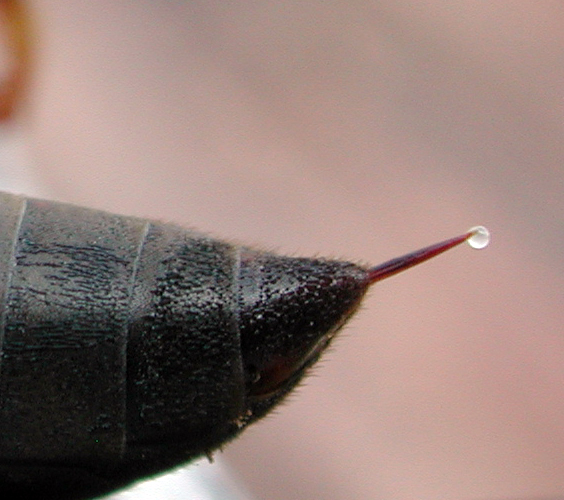Venom
Editor-In-Chief: C. Michael Gibson, M.S., M.D. [1]
Venom (literally, poison of animal origin) is any of a variety of toxins used by certain types of animals, for the purpose of defense and hunting. Generally, venom is injected while other toxins are absorbed by ingestion or through the skin.

The animals most widely known to use venom are snakes, some species of which inject venom into their prey through hollow fangs; spiders and centipedes, which also inject venom through fangs; scorpions and stinging insects, which inject venom with a sting (which is a modified egg-laying device - the ovipositor). There are also many caterpillars that have defensive venom glands associated with specialized bristles on the body, known as urticating hairs, some of which can be lethal to humans (e.g., the Lonomia moth). Venom is also found in other reptiles besides snakes such as the gila monster, and mexican beaded lizard. Other insects, such as true bugs [2], also produce venom. Venom can also be found in some fish, such as the cartilaginous fishes: stingrays, sharks, and chimaeras and the teleost fishes, which include: monognathus eels, catfishes, stonefishes and waspfishes, scorpionfishes and lionfishes, gurnard perches, rabbitfishes, surgeonfishes, scats, stargazers, weevers, carangids, saber-toothed blenny, and toadfish. In fact, recent studies have shown that there are more venomous ray-finned fishes than all other venomous vertebrates combined. Additionally, there are many other venomous invertebrates, including jellyfish, cone snails, bees, wasps and ants. The Box jellyfish is widely considered the most venomous creature in the world.[3] Some mammals are also venomous, including solenodons, shrews, the slow loris, and the male platypus.
Because they are tasked to defend their hives and food stores, bees synthesize and employ an acidic venom (apitoxin) to cause pain in those that they sting, whereas wasps use a chemically different venom designed to paralyze prey, so it can be stored alive in the food chambers of their young. The use of venom is much more widespread than just these examples, of course.
It is important to note the difference between organisms that are "venomous" and "poisonous", two commonly confused terms with regards to plant and animal life. Venomous, as stated above, refers to animals that inject venom into their prey as a self-defense mechanism. Poisonous, on the other hand, describes plants or animals that are harmful when consumed or touched. One species of bird, the hooded pitohui, although not venomous, is poisonous, secreting a neurotoxin on to its skin and feathers. The slow loris, a primate, blurs the boundary between poisonous and venomous; it has poison secreting patches on the inside of its elbows which it is believed to smear on its young to prevent them from being eaten. However, it will also lick these patches, giving it a venomous bite.
Snake venom
Snake venom is produced by glands below the eye and delivered to the victim through tubular or channeled fangs. Snake poisons contain a variety of peptide toxins. Snakes use their venom principally for hunting, though the threat of being bitten serves also as a defense. Snake bites cause a variety of symptoms including pain, swelling, tissue damage, low blood pressure, convulsions, and hemorrhaging (varying by the species of snake).
Doctors treat victims of a venomous bite with antivenom, which is created by dosing an animal such as a sheep, horse, goat, or rabbit with a small amount of the targeted venom. The immune system of the subject animal responds to the dose, producing antibodies against the venom's active molecule, which can then be harvested from the animal's blood and applied to treat envenomation in others. This treatment may be effective for a given person only a limited number of times, however, as that person will ultimately develop antibodies to neutralize the foreign animal antibodies injected into him. Even if that person doesn't suffer a serious allergic reaction to the antivenom, his own immune system can destroy the antivenom, before the antivenom can destroy the venom. Though most people never require one treatment of antivenom in their lifetime, let alone several, people who work with snakes or other venomous animals may. Fortunately, these people often develop antibodies of their own against the venom of whatever animals they handle, and thereby are immune without assistance of exogenous antibodies.
See also
- Toxin
- Poison
- Toxinology
- Schmidt Sting Pain Index
- Venomous mammals
- Venomous fish
- Big Four (Indian snakes)
- Envenomation
- Venomous animals (category)
References
Leo Smith and Ward C. Wheeler. 2006. Venom evolution widespread in fishes: A phylogenetic road map for the bioprospecting of piscine venoms. Journal of Heredity 97(3): 206-217.